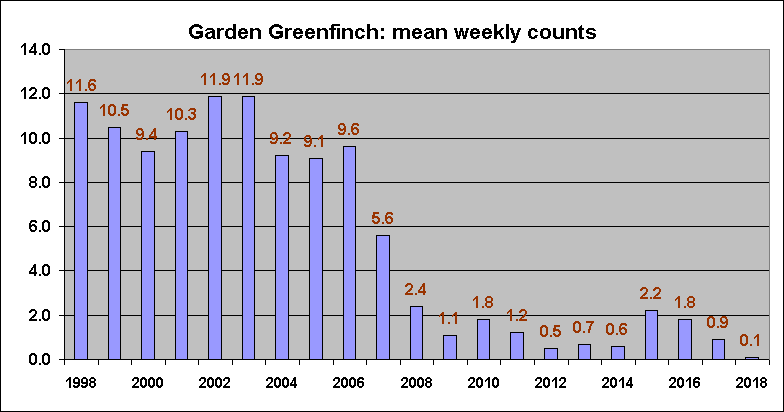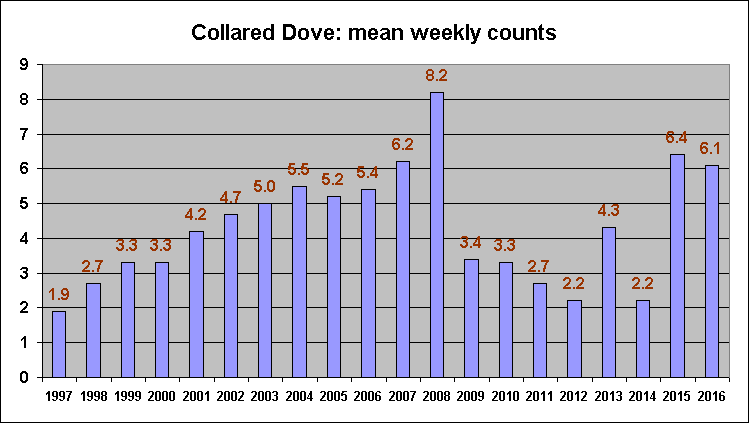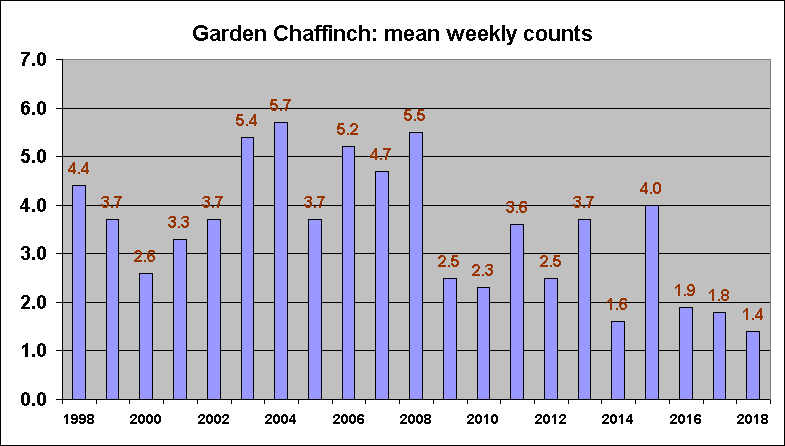RETURN TO . . . Emsworth Wildlife - Homepage
BIRDS IN MY GARDENLink to . . . Garden recent news
MY GARDENWe moved to our present house in Bridge Road, near the centre of Emsworth in May 1997 after spending about 30 years in an old Edwardian house in North Emsworth. The present garden is considerably smaller than my previous one and has fewer species of bird visiting it. However, we are lucky in having a fairly open aspect despite being close to the centre of town. I can see the whole garden from the house and watch at various times during the day. At the end of the garden at the other side of the brick wall is a small stream (the Westbrook), which runs down to Emsworth Millpond. The stream occasionally attracts unusual visitors, like Little Egret, Kingfisher and Grey Wagtail which perch on the wall and sometimes come into the garden.
View of the bird feeding area with feeders on the Cherry tree - 1 November 2017
Feeding birds
I put food out daily for the birds throughout the year. The tree on the right is a flowering cherry from which I have three seed holders and two fat ball holders. I used to fill the holders exclusively with sunflower hearts, but as an experiment (from October 2017) I used a mixture of sunflower hearts and mixed seed mainly to cut down on the expense of the sunflowers. To encourage the Collared Doves and Woodpigeons to mop up the droppings beneath the feeders I removed the bird table which previously had a supply of bird seed. So far it is working well and I am getting less droppings.
I have given up using peanuts in hangers as the birds ignore them and the peanuts go mouldy. I have also stopped using niger seed holders as the seeds constantly fell onto the gound where they created a soggy mess. Birds far prefer sunflower hearts. I put apples out, but they are rarely touched except in very cold weather. There is a bird bath which can be seen in the photo which is well used, particularly by Starlings.Squirrels
As I write (Jan 2019) I am getting regular visits from two Grey Squirrels. All my feeders are constructed from metal so the Squirrels do not damage them, but they do take a fair amount of food. They are particularly partial to fat balls. I have tried scattering peanuts to distract them from the feeders, but that did not work. They simply picked up the nuts and buried them around the garden returning to feed on the fat balls,etc. I now love 'em and hate 'em.Cats
We don't have a cat, but I think most of our neighbours have at least one. They seem to have regular routes through our garden which I did try to block off, but that was a total failure. Cats are far to agile to be stopped by simple barriers. I invested in a Catwatch which the RSPB said would scare off cats but it did not work. They do stalk birds, hiding behind a bush, but I have not seen a cat actually catch a bird. However, I think they do help to keep the local Brown Rat population under control.
Bird recording
I have taken part in both BTO garden bird record schemes: Garden Birdwatch (GBW) scheme since its inception in 1995 and Garden Bird Feeding Survey (GBFS) from 1992-97. Weekly records have been kept of the maximum number of birds of each species seen at any one time in the back garden. Only birds that actually use the garden or hunt over the garden (e.g, Swifts) are counted. Those just flying over like gulls and geese are not counted. The list below shows the each bird species seen in the garden up to 12 November 2012 - records completed for 792 weeks. The birds in the list are ranked according to the total number of weeks the species was recorded. The total number is 47.
GARDEN BIRD LIST . . . UP TO 12 NOV 2012TO BE UPDATED
SPECIES
Rank
Weeks
Collared Dove
1
764
Backbird
2
696
House Sparrow
3
693
Greenfinch
4
680
Chaffinch
5
632
Blue Tit
6
611
Starling
7
596
Robin
8
507
Woodpigeon
9
460
Goldfinch
10
442
Dunnock
11
425
Great Tit
12
300
Swift
13
199
Magpie
14
180
Song Thrush
15
161
Wren
16
155
Little Egret
17
68
Blackcap
18
54
Long-tailed Tit
19
44
Coal Tit
20
31
Carrion Crow
21
29
Sparrowhawk
21
29
Chiffchaff
23
24
Goldcrest
24
19
Grey Wagtail
25
8
Pied Wagtail
26
7
Siskin
27
6
Willow Warbler
27
6
Black-headed Gull
29
5
Brambling
29
5
Jackdaw
29
5
Kingfisher
29
5
Great Spotted Woodpecker
33
4
Redwing
33
4
Yellowhammer
33
4
Bullfinch
36
3
Feral Pigeon
37
2
Fieldfare
37
2
Mallard
37
2
Pheasant
37
2
Stock Dove
37
2
Turtle Dove
37
2
White Dove
37
2
Cuckoo
44
1
Jay
44
1
Mistle Thrush
44
1
Redstart
44
1
ANNUAL CHANGES IN MY GARDEN BIRDSThe above list conceals a good deal of change in the fortunes of the garden birds over the 15 years with some going up the list while others have declined. The big winners have been Goldfinch and Woodpigeon and the main losers were House Sparrow, Starling and Greenfinch.
GOLDFINCH
Goldfinches have increased dramatically over the years in all gardens, including mine. The big increase came in 2004 when I started using niger seeds, though they now feed exclusively on sunflower hearts from the feeders. From being fairly rare birds in the garden Goldfinches are now my number one bird both in reliability and numbers. The chart gives the mean weekly count of Goldfinches in the garden over each year. There was an unusual fall in 2014.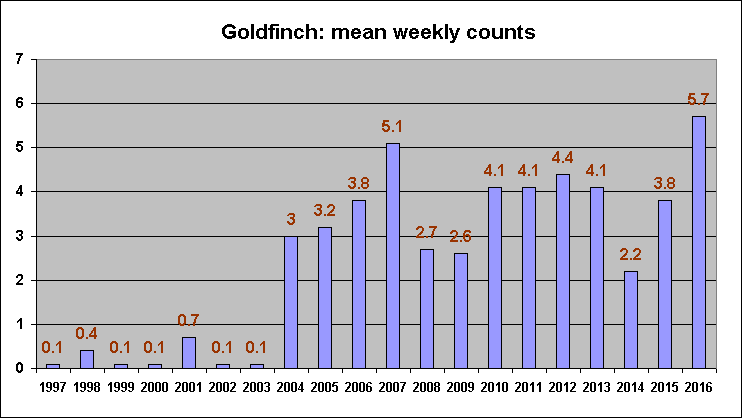
WOODPIGEON
Woodpigeons have steadily increased in my garden over the past 15 years, as they have generally in gardens across the country. The big increase in my garden was between 1998 and 2008 as shown in the following chart , which plots the mean weekly count of Woodpigeons each year. There has been a levelling out after that peak, but they are still a very regular bird in the garden virtually every day.
HOUSE SPARROWS
One of the main losers in garden birds has been the House Sparrow. Numbers have been declining fairly steadily in the garden for the past 10 years, much in line with the general decline as recorded in BTO surveys. The mean weekly count in 1998 was 15.4 from where it fell to 6.7 in 2002. There was a recovery to 10.4 in 2005, but then numbers plumetted down to 0.9 in 2012.
However, there are signs of a recovery. In 2013 and 2014 House Sparrows were more frequent in the garden and the mean weekly counts showed a modest increase as shown in the chart.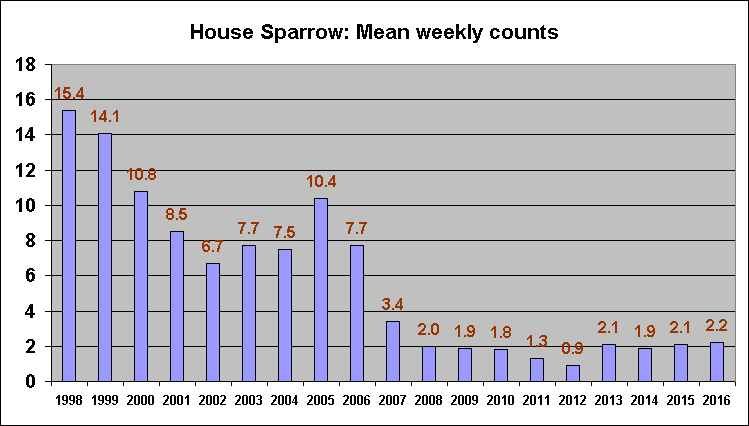
BTO Garden Birdwatch scheme also reported a slight recovery in House Sparrow numbers following a big drop that occurred in the middle of last decade. Since 2008 a noticeable, steady upturn in GBW counts has been recorded.
STARLINGS
Starling numbers in the garden have also slumped over the years. As shown in the following chart, numbers were very healthy in the early 2000s and they were regularly seen in the garden, sometimes swooping down in huge numbers to take food. But since 2003 numbers have taken a tumble and they are now one of the least seen of the once regular birds. However, like House Sparrow, there appears to have been a slight revival over the past two years as shown in the following chart.
GREENFINCH
Greenfinch used to be my top garden bird with a 100% record, and cost me a load of money in sunflower hearts until 2006. However, from 2007 their numbers plumetted. The BTO reported a large decline in the Greenfinch breeding population following the outbreak of trichomonosis in 2006 - from 4.3 million to 2.8 million birds. My garden finches have suffered also from this disease. Sadly, there is no real sign of a permanent recovery.
COLLARED DOVE
Collared Dove numbers rapidly increased in the garden from the start of counting in 1997 to a peak in 2008. Since then there has been a sharp slump in numbers.
CHAFFINCH
Like Collared Dove, Chaffinch numbers have had a slump since 2008. Not sure of the reason, though it is probably associated with the disease trichomonosis which mainly affected the finches.



